
Tunisia Odyssey: Historic North
Bicycle Africa / Ibike Tours
Dispatch 8 - El Kef
After a typical hotel breakfast, we loaded our bikes. The several stork nests that overlooked the hotel parking lot were already showing signs of life and one couple were clacking their bills at each other.
We rode through a small market that was not yet in full swing and were soon out of town. It was cool and stayed relatively cool throughout our ride – a nice surprise. Ground fog blanked the fields up the valley, but generally burned off before we got to it.
 The country for the first half of the ride
was flat and agricultural, mostly wheat. Prickly pear cactus line some of
the field. A month later the fruit will be ripe. We have been
here in April before when the wheat was golden and already being harvested.
This year both the north and the south have received
The country for the first half of the ride
was flat and agricultural, mostly wheat. Prickly pear cactus line some of
the field. A month later the fruit will be ripe. We have been
here in April before when the wheat was golden and already being harvested.
This year both the north and the south have received copious rain and the
land shows it.
copious rain and the
land shows it.
 We passed a group of out ten storks
congregated in a field relatively close together. We have never heard
of cooperative hunting with storks, so we assume it was some sort of
social gathering.
We passed a group of out ten storks
congregated in a field relatively close together. We have never heard
of cooperative hunting with storks, so we assume it was some sort of
social gathering.
 Later
flat turned into an inclined plane.
Later
flat turned into an inclined plane.
 The
grades weren’t tough, but they were persistent. Up in
the hills there were more forests and more mixed agricultural activities.
Hidden away must be major bee keeping activities because we passed a number
of honey sale sites as we bicycled along.
The
grades weren’t tough, but they were persistent. Up in
the hills there were more forests and more mixed agricultural activities.
Hidden away must be major bee keeping activities because we passed a number
of honey sale sites as we bicycled along.
At the top of the hill was a higher plateau. With each bend in the
road the landscape seemed to get more and more beautiful,
 and
there were
fresh and new snapshots into life in Tunisia: women in a
and
there were
fresh and new snapshots into life in Tunisia: women in a
 field taking and
watching their sheep graze (left) and communities of the traditional tents of
Bedouins (right). By the time we stopped
for thé at a major crossroad, we had finished eighty percent of the
ride and were ready for a break. For those who are keeping track, we were
again picked up
by a discrete security escort for part of the way. While we refreshed
ourselves and enjoyed the Tunisian café life,
they chatted with the uniformed police at the crossroads.
field taking and
watching their sheep graze (left) and communities of the traditional tents of
Bedouins (right). By the time we stopped
for thé at a major crossroad, we had finished eighty percent of the
ride and were ready for a break. For those who are keeping track, we were
again picked up
by a discrete security escort for part of the way. While we refreshed
ourselves and enjoyed the Tunisian café life,
they chatted with the uniformed police at the crossroads.

 After thé, we turned west and had a
nice tailwind which whisked us through verdant countryside and along at high speed.
This is when bicyclist feel that there is justice in the world.
After thé, we turned west and had a
nice tailwind which whisked us through verdant countryside and along at high speed.
This is when bicyclist feel that there is justice in the world.
 This free ride stop abruptly when
we hit the final climb to el Kef. But that is just bicycling.
It is a little more challenging when there is a group of students
scrutenizing you at the top of the hill. You have the urge to smile,
keep your chin high and not look like you are breathing hard.
This free ride stop abruptly when
we hit the final climb to el Kef. But that is just bicycling.
It is a little more challenging when there is a group of students
scrutenizing you at the top of the hill. You have the urge to smile,
keep your chin high and not look like you are breathing hard.
 El Kef's
Punic period name is Sicca Citadelle. In the Roman era is was
called Sicca Veneria and Cirta Nova. And the Arabs use the
name Chakbanaria for the city. What ever the name, we were staying here for two nights.
A couple of well traveled members of the explained that on extended tours, after a few
months, whenever there is a stop in one place for more than one night you call
it “home.”
El Kef's
Punic period name is Sicca Citadelle. In the Roman era is was
called Sicca Veneria and Cirta Nova. And the Arabs use the
name Chakbanaria for the city. What ever the name, we were staying here for two nights.
A couple of well traveled members of the explained that on extended tours, after a few
months, whenever there is a stop in one place for more than one night you call
it “home.”
 El Kef lies in the Tell, a transition zone
between the verdant north and dry south. It sits high on the side of a hill
with commanding views of the surrounding area. Not surprisingly an old fort
or kasbah dominates the upper part of the city. It must have
been a nice region to live in for a long time because they have found stone
age site dating back to 2000 century BC at Kebili, Metlaoui, Redeyef, Gafsa
and El Kef. Six kilometers south, in Sidi Zine is a 450 century BC
stone age site. In the 4th century BC el Kef was a Punic/Numidian
cultural center and military base. The "modern" town was founded
by Carthage as an outpost to protect its western boundary. When Carthage
fell, the Numidians rebelled against the Romans but were eventually quashed.
They were also part of the secessionists in the Jugurthan War. The
Vandals and Byzantines also passed this way before the Arabs took over, and
the people of the region continued to exert their autonomous tendencies
throughout all of this. The Ottomans revitalized the city adding new
fortifications.
El Kef lies in the Tell, a transition zone
between the verdant north and dry south. It sits high on the side of a hill
with commanding views of the surrounding area. Not surprisingly an old fort
or kasbah dominates the upper part of the city. It must have
been a nice region to live in for a long time because they have found stone
age site dating back to 2000 century BC at Kebili, Metlaoui, Redeyef, Gafsa
and El Kef. Six kilometers south, in Sidi Zine is a 450 century BC
stone age site. In the 4th century BC el Kef was a Punic/Numidian
cultural center and military base. The "modern" town was founded
by Carthage as an outpost to protect its western boundary. When Carthage
fell, the Numidians rebelled against the Romans but were eventually quashed.
They were also part of the secessionists in the Jugurthan War. The
Vandals and Byzantines also passed this way before the Arabs took over, and
the people of the region continued to exert their autonomous tendencies
throughout all of this. The Ottomans revitalized the city adding new
fortifications.


 The
location and layout of the town make large section of it car-free. The
old section of town is characterized by narrow
The
location and layout of the town make large section of it car-free. The
old section of town is characterized by narrow
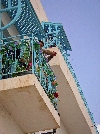 stairways
that zig-zag their way between whitewashed buildings with turquoise blue
shuttered windows and doors, up the hillside.
stairways
that zig-zag their way between whitewashed buildings with turquoise blue
shuttered windows and doors, up the hillside.
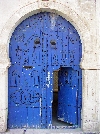 Besides being picturesque and environmentally wonderful, the people living
in these sections of the town are more relaxed, smiling and welcoming.
At least some citizens of el Kef recognized this asset because there is an
active Society for the Preservation of the Medina of el Kef, in a grand old
building near the Roman ruins. The city today is not yet on the main
tourist route, but given its location, tranquility and charm, it’s only a
matter of time.
Besides being picturesque and environmentally wonderful, the people living
in these sections of the town are more relaxed, smiling and welcoming.
At least some citizens of el Kef recognized this asset because there is an
active Society for the Preservation of the Medina of el Kef, in a grand old
building near the Roman ruins. The city today is not yet on the main
tourist route, but given its location, tranquility and charm, it’s only a
matter of time.

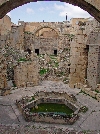 After check-in, a short rest, and lunch,
we took a walking tour of the city’s historical highlights. We
stopped at the ruins of an old Roman bath in the center of the town; demonstrating yet again how
ancient civilizations tend to get buried beneath many feet of stuff. The
level of the city during Roman times appears to be a good ten to twenty feet
below the level of the current city. Our next stop was the Great Mosque also
After check-in, a short rest, and lunch,
we took a walking tour of the city’s historical highlights. We
stopped at the ruins of an old Roman bath in the center of the town; demonstrating yet again how
ancient civilizations tend to get buried beneath many feet of stuff. The
level of the city during Roman times appears to be a good ten to twenty feet
below the level of the current city. Our next stop was the Great Mosque also called the
called the
 Basilica St Augustine which has a confused history. Evidently built by the
Byzantines in the third century as a church or monastery, it was sometime
later reinvented as a tax collection post and you can still see the
Basilica St Augustine which has a confused history. Evidently built by the
Byzantines in the third century as a church or monastery, it was sometime
later reinvented as a tax collection post and you can still see the
 stone
hooks built into the wall where petitioners could hitch and feed their horses.
stone
hooks built into the wall where petitioners could hitch and feed their horses.
 Still later a cupola was erected over
the courtyard and the building was transformed into a mosque. Now, with the cupola
removed in 1968, it is a small museum where the attendant, as at all the “free”
sites, expects baksheesh (a tip) for showing you around.
Still later a cupola was erected over
the courtyard and the building was transformed into a mosque. Now, with the cupola
removed in 1968, it is a small museum where the attendant, as at all the “free”
sites, expects baksheesh (a tip) for showing you around.
 A
couple doors up is an 18th C Foundouk. A few years
ago you could poke around the courtyard where travelers used to stay and
prepare for onward journeys, but now we had to be satisfied with the view in
from the hill behind the building.
A
couple doors up is an 18th C Foundouk. A few years
ago you could poke around the courtyard where travelers used to stay and
prepare for onward journeys, but now we had to be satisfied with the view in
from the hill behind the building.
 After
a short wait for the door keeper, were able to visited the Mosque of Sidi
Bou Makhlouf (Jemda el Kebir),
After
a short wait for the door keeper, were able to visited the Mosque of Sidi
Bou Makhlouf (Jemda el Kebir),
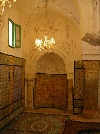 a
17th century mosque built in honor of the city’s
patron saint or sidi from Morocco. The sidi’s tomb and that of his family
are here. As the mosque is no
a
17th century mosque built in honor of the city’s
patron saint or sidi from Morocco. The sidi’s tomb and that of his family
are here. As the mosque is no
 longer used as such, we could enter and look
around. This mosque is very beautiful, with distinctive architecture, but
more modest than many others. It main architectural features are three
cupolas and 19th century octagonal minaret.
longer used as such, we could enter and look
around. This mosque is very beautiful, with distinctive architecture, but
more modest than many others. It main architectural features are three
cupolas and 19th century octagonal minaret.
We paid a visit to the local Museum of Art & Popular Tradition, a
nicely done, small museum set in a seventeenth century zaouia,
honoring Rakmania. Rakmania was a Shiia, but the Islamic schools in
Tunisia were Sunni -- this doesn't seem to cause a concern or discomfort on
the part of those we have been able to ask about it.
 The
complex surrounding the tomb of a saint, this time one
The
complex surrounding the tomb of a saint, this time one
 Sidi Ali ben Aissa
(1666). The four elements of the zaouia can still be distinguished but
they have now been converted into exhibit halls: principle room or parlor
(clothing exhibit), prayer hall (lifestyle exhibit), koranic school (equestrian
exhibit), and residence
(pottery/blacksmith exhibit).
Sidi Ali ben Aissa
(1666). The four elements of the zaouia can still be distinguished but
they have now been converted into exhibit halls: principle room or parlor
(clothing exhibit), prayer hall (lifestyle exhibit), koranic school (equestrian
exhibit), and residence
(pottery/blacksmith exhibit).
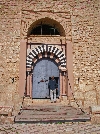
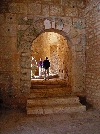 While at the museum a runner came to tell us the kasbah was now open.
It seems the local site curators communicate via cell phones and were
keeping track of our progress.
While at the museum a runner came to tell us the kasbah was now open.
It seems the local site curators communicate via cell phones and were
keeping track of our progress.
The kasbah is the first thing to
catch your eye when you near the city. Looking like a fairy tale fort, it
looms
 over the city
over the city
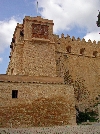 with high walls looking very forbidding. Some type of
fort has stood her since 5 BC. The base of the smaller fort of the current structure was built by the
Byzantines in the sixth century AD and then reinforced by the
with high walls looking very forbidding. Some type of
fort has stood her since 5 BC. The base of the smaller fort of the current structure was built by the
Byzantines in the sixth century AD and then reinforced by the
 Ottomans
in the sixteenth century. The famous
leader Ali Pasha, who initiated a number of significant projects during his
reign from 1734 to 1756, built the Kasba in 1740 -- the larger fort. The fort itself is
Ottomans
in the sixteenth century. The famous
leader Ali Pasha, who initiated a number of significant projects during his
reign from 1734 to 1756, built the Kasba in 1740 -- the larger fort. The fort itself is interesting to walk
interesting to walk through.
Along the entrance way the are Turkish mortars and French canons. It has
it's own cistern, soldiers quarters, munitions magazine, mess, Pasha's quarters
and mosque. The
through.
Along the entrance way the are Turkish mortars and French canons. It has
it's own cistern, soldiers quarters, munitions magazine, mess, Pasha's quarters
and mosque. The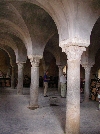 mirab in the mosque in
mirab in the mosque in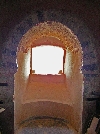 highly unusual in that it has a window -- the view from
the window just happens to be as beautiful as can be found in these parts in the
direction of Mecca (lower right). As
part of its history the fort also serve as a military prison for the Turkish and
a prison for political prisoners for the French. Perhaps the most
distinguished rabble rousing resident (political prisoner)
highly unusual in that it has a window -- the view from
the window just happens to be as beautiful as can be found in these parts in the
direction of Mecca (lower right). As
part of its history the fort also serve as a military prison for the Turkish and
a prison for political prisoners for the French. Perhaps the most
distinguished rabble rousing resident (political prisoner) was Habib Bourguiba
(1942), later
to be the
was Habib Bourguiba
(1942), later
to be the first President of modern independent Tunisia. It is possible to
view the cell where he was held. himself was once held in a
cell (left). A look into the cells convinces you this
would not have been a pleasant abode. The real delight at the Kasbah,
though, is the view out over the city and back towards the mountain where an
ancient Roman quarry is still worked
first President of modern independent Tunisia. It is possible to
view the cell where he was held. himself was once held in a
cell (left). A look into the cells convinces you this
would not have been a pleasant abode. The real delight at the Kasbah,
though, is the view out over the city and back towards the mountain where an
ancient Roman quarry is still worked
 today. You don’t often get a view down
into the convolutions of a Tunisian town with the narrow streets twisting
and turning into a labyrinthine maze. This bird’s eye perspective gives a
bit further insight into the lives of the people here.
today. You don’t often get a view down
into the convolutions of a Tunisian town with the narrow streets twisting
and turning into a labyrinthine maze. This bird’s eye perspective gives a
bit further insight into the lives of the people here.

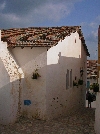 After leaving the kasbah we headed down
the hill to the fifth century hara.
Hara is a word for the Jewish quarter around Tunisia. The several
hundred strong Jewish population of el Kef started to vacated in the 1970's and
was virtually gone by 1980. At
After leaving the kasbah we headed down
the hill to the fifth century hara.
Hara is a word for the Jewish quarter around Tunisia. The several
hundred strong Jewish population of el Kef started to vacated in the 1970's and
was virtually gone by 1980. At
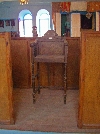 this
time it is hard to tell the full extent of the former community, but it is still
possible to see the former Jewish souk (commercial district) and to visit
the nearby synagogue ghriba (strangers). The synagogue is no longer
used for religious education or
this
time it is hard to tell the full extent of the former community, but it is still
possible to see the former Jewish souk (commercial district) and to visit
the nearby synagogue ghriba (strangers). The synagogue is no longer
used for religious education or
 rituals,
and now is arranged more as a museum. In the collection are a circumcision
chair, an ark with two torah scrolls in protective wooden cases, a couple walls
of memorial
rituals,
and now is arranged more as a museum. In the collection are a circumcision
chair, an ark with two torah scrolls in protective wooden cases, a couple walls
of memorial
 plagues,
historical photos of
plagues,
historical photos of
 families
and events in the former Jewish community and a couple square collection cans.
One of the collection cans said "Palestine Orphan Society" and the other was
imprinted
families
and events in the former Jewish community and a couple square collection cans.
One of the collection cans said "Palestine Orphan Society" and the other was
imprinted
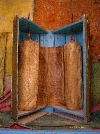
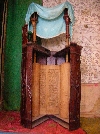 "State
of Israel". Each had a slot in the top for putting donation into.
The items became more curious to us because they were the only items in the
collection that we explicitly weren't allowed to photograph. We could not
get an explanation for the special treatment of the cans and couldn't devise one
by ourselves.
"State
of Israel". Each had a slot in the top for putting donation into.
The items became more curious to us because they were the only items in the
collection that we explicitly weren't allowed to photograph. We could not
get an explanation for the special treatment of the cans and couldn't devise one
by ourselves.
Walking back from the synagogue you can walk on a stone street the dates back to Roman times. Along this road you pass the 4th century AD Dar el Kouss (Byzantine church). It has a large hall with central nave.

 Back at the hotel,
we had the choice of a private courtyard which was dominated by an orange tree
or the view
from the room window which overlooks the backside of the kasbah we were so
recently atop. Down slope from the kasbah a shepherd watched his
sheep grazing the lush grass of the hillside. We could lie in bed watching
the antics of the young lambs when we put our feet up for a short nap before
supper.
Back at the hotel,
we had the choice of a private courtyard which was dominated by an orange tree
or the view
from the room window which overlooks the backside of the kasbah we were so
recently atop. Down slope from the kasbah a shepherd watched his
sheep grazing the lush grass of the hillside. We could lie in bed watching
the antics of the young lambs when we put our feet up for a short nap before
supper.
 We had two new (to us) dishes at supper; a mess of lamb short ribs in a red stew that was very good,
and dish described as beef in a green sauce, which was less popular -- to
put it mildly. The green
sauce was dark enough be called black and looked like a thick oil slick and
covered his beef in a sort of soup. It reminded some, in looks, texture, and a
little in taste of a mole sauce. We could not figure out what exactly the
green sauce was. Later investigation suggests that the sauce is made
from a leaf that comes from closer to the coast. It doesn't seem to be
well known, even among Tunisians, and the wasn't a know French or English
name for the leaf by our informants.
We had two new (to us) dishes at supper; a mess of lamb short ribs in a red stew that was very good,
and dish described as beef in a green sauce, which was less popular -- to
put it mildly. The green
sauce was dark enough be called black and looked like a thick oil slick and
covered his beef in a sort of soup. It reminded some, in looks, texture, and a
little in taste of a mole sauce. We could not figure out what exactly the
green sauce was. Later investigation suggests that the sauce is made
from a leaf that comes from closer to the coast. It doesn't seem to be
well known, even among Tunisians, and the wasn't a know French or English
name for the leaf by our informants.
 For lunch the next day some of the group returned to the restaurant where
we had had lunch the day before try the ojja. The owner recognized
the foreign faces immediately and invited us in. As we enjoyed a
delicious after lunch thé, the owner’s husband (I think) came out
from the back and showed us postcards he had received from America along
with photos of he, his wife, and other foreign patrons. Upon leaving we got
the same anti-Bush comment as before. He sure has made himself unpopular.
For lunch the next day some of the group returned to the restaurant where
we had had lunch the day before try the ojja. The owner recognized
the foreign faces immediately and invited us in. As we enjoyed a
delicious after lunch thé, the owner’s husband (I think) came out
from the back and showed us postcards he had received from America along
with photos of he, his wife, and other foreign patrons. Upon leaving we got
the same anti-Bush comment as before. He sure has made himself unpopular.
Speaking of unpopular, Sakiet Sidi Youssef is a village south of el Kef bombed by French in the 1960's. They alleged it was a base for Algerian Independence fighters who were challenging French colonial rule. After this violation of their sovereignty the Tunisian began pressuring the French to leave.
 On
the needs-further-information-to-understand list is this tree along the road
to Hammam Mellegue. Strung in the tree were dozens of pieces of
clothing and cloth. It seemed very deliberate but was far too tattered
and seemed to have been there too long to be clothing left in the tree to
dry.
On
the needs-further-information-to-understand list is this tree along the road
to Hammam Mellegue. Strung in the tree were dozens of pieces of
clothing and cloth. It seemed very deliberate but was far too tattered
and seemed to have been there too long to be clothing left in the tree to
dry.
 Another local
curiosity is this sign which marks some kind of point of geological
significance. It was also off the main road, on the road to Hammam
Mellegue. None of the local stopped at it or seemed to give it any
attention. Maybe they had all read it years ago.
Another local
curiosity is this sign which marks some kind of point of geological
significance. It was also off the main road, on the road to Hammam
Mellegue. None of the local stopped at it or seemed to give it any
attention. Maybe they had all read it years ago.
A pleasant side trip for El Kef is to the second century Roman Baths at Hammam Mellegue.
The route starts out relatively flat across the high plateau.

There
is an interesting military sign along the way that we never got translated.
We accepted that the gist was at least "keep out". About half




way into the trip to the baths the terrain got more rugged and the road started to descend the escarpment. Descending the views were spectacular but it was hard to get away from the thought that
 we would have to climb back up in a few hours.
we would have to climb back up in a few hours.

At the bottom, next to the Mellegue River was a Roman ruin, and in the bowels of
the ruins was a bath that was still being operated. Before indoor plumbing
at every house was so common, Tunisians would go to the public baths several
times a week, if not daily, but this has changed. It seemed like a very
remote location for such a going concern.
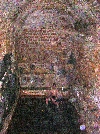
After passing through a massive door, we descended a steep stone staircase to a 10x15 ft pool with small rooms on either side for changing. Though lit by arched skylights the place was gloomy at best. There were already eight men in the bath. We changed into shorts (no one goes naked in the baths) and entered the bath which reached not quite to the knee when standing.
Our entry caused a flurry of activity. While some of the men had been soaping themselves or scrubbing each other with an abrasive glove called a kassa (to remove a layer or two of dead skin), all this ceased as we clambered in and, instead, two men began searching the floor. We soon realized they were pulling the plug to let out the dirty water while keeping the fresh water from coming in through a hole in the stone about knee high. It took awhile for all the water to drain while everyone swept the last remnants toward the plug hole. During this time there was a lively conversation in French and a little English with two young men who had walked here from el Kef this morning. Everyone was friendly and welcoming though a few of the men took this break to leave the hammam.
When drained you could see that the bottom and sides
consist of large stone blocks, deeply pitted and surprisingly not slippery
to walk on. One wonders if this calderia has been in constant use the
last eighteen hundred years. The water coming in was already at a
comfortable temperature. Surprisingly, the ride back, even the steep climb
which immediately confronted us upon exiting the hammam, did not seem
too bad … or maybe we were just too mellow to notice. We just geared down
and cranked on up. It actually seemed shorter going up than coming down as
it paradoxically often does.


Back at the top it flattened out again and the biggest challenge became herds of sheep.
![]()
![]()
Unique Programs To Special Places For Memories Of A Lifetime!
![]()
![]() Please
write if you have questions, suggestions and comments about our program or want to be
added to Bicycle Africa's mailing list. (Also let us know how you found this site.)
Please
write if you have questions, suggestions and comments about our program or want to be
added to Bicycle Africa's mailing list. (Also let us know how you found this site.)














